Girlfighting: Betrayal and Rejection Among Girls
Girlfighting is a serious and intelligent analysis of the cruelty and meanness involved in girls' relationships at each stage of development. The book is also a political challenge to what author Lyn Mikel Brown sees as the destructive messages foisted on girls by a patriarchal world. And therein lies part of the dilemma of the book. In trying to serve two masters, Brown, who is a respected academic and serious student of the life of girls, sometimes has difficulty serving either as well as she might.
Brown's book documents the manifestations of girlfighting as girls mature from early girlhood to late adolescence, from gossip and cliques to shaming and hurtful exclusion and name calling. She bases her observations on interviews with girls from first grade to high school and has included the voices of a range of girls with respect to race and economic privilege. Brown is at her best when she is listening to the girls in her sample. She has a wonderful ear for hearing the way girls really talk to each other and the way they explain their experiences to themselves and others. The reader can hear the confusion, anger, and at times sadness as the girls tell of their complicated relationships with other girls.
Brown tells the reader early in the introduction that she wants to explore the impact of culture on the relationships that girls have with other girls. Unfortunately, Brown makes the links largely by assertion between what she hears girls say and the culture she perceives. After discussing the back stabbing and betrayal that Brown feels is rampant during middle school. For example, she asserts, "The betrayals girls enact on each other derive largely from the rejection of their marginal place in the social order and their desire to have power—to be visible and taken seriously." Brown fails to give the reader a reason to believe this assertion. Those who share her political perspective will most likely agree with her conclusion, but those who are still struggling with trying to understand why we behave the way we do will not be persuaded.
Her last chapter, titled "This Book Is an Action," articulates an empowerment template for any oppressed group. Brown is especially clear that girls and the people who support and care about them must talk back to the messages of oppression. First, they must accurately read the situation that has transpired and break down the sexist-racist-classist messages; then they must correctly label or name the oppression, an act that brings it into the light. The next steps involve finding ways to resist the oppression and ultimately replacing the old attitudes with new feelings, attitudes, and behaviors. By putting girlfighting into the context of other types of oppression, Brown ultimately does give us a reason to care about behavior that at times seems trivial and not emotionally comparable to the sexual and physical abuse that haunts so many young girls and boys. Girlfighting emerges as a challenging, albeit somewhat flawed, work.
Dr. Harris is chief executive officer for clinical affairs at Community Connections in Washington, D.C., and the author of several books on trauma and abuse.



